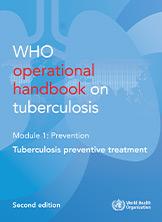Module 1: TB preventive treatment

 Feedback
Feedback
Web Annex A. Methods and expert panels https://apps.who.int/iris/bitstream/handle/10665/362242/9789240055902-eng.pdf
Web Annex B. GRADE evidence summary tables https://apps.who.int/iris/bitstream/handle/10665/362243/9789240055919-eng.pdf
During the guideline development process, the Guideline Development Group identified important knowledge gaps that need to be closed through both primary and secondary research in order to better inform the adoption of current IPC practices and, potentially, of new practices.
The general research gaps listed below are to be prioritized for all IPC interventions:
The threats posed by epidemics, pandemics and AMR have become increasingly evident as ongoing universal challenges, and they are now recognized as a top priority for action on the global health agenda. Effective IPC is the cornerstone of such action. The International health regulations position effective IPC as a key strategy for dealing with public health threats of international concern (70).
Respiratory protection controls are designed to further reduce the risk of exposure to M. tuberculosis (and other airborne pathogens) for health workers in special areas and circumstances. The recommendations given here are aimed at strengthening these controls, and preventing the inadequate implementation of respiratory protection programmes that may lead to a false sense of security and therefore increase the risk to health care staff.
To reduce the risk of transmission of M. tuberculosis, air can be made less infectious through the use of three principles: dilution, filtration and disinfection. Environmental controls are aimed at reducing the concentration of infectious droplet nuclei in the air. This is achieved by using special ventilation systems to maximize airflow rates or filtration, or by using germicidal ultraviolet (GUV) systems to disinfect the air.
A set of administrative controls is the first and most important component of any IPC strategy. These key measures comprise specific interventions aimed at reducing exposure and therefore reducing transmission of M. tuberculosis. They include triage and patient separation systems (i.e. management of patient flows to promptly identify and separate presumptive TB cases), prompt initiation of effective treatment and respiratory hygiene.
The recommendations given below on TB-specific interventions are not envisioned as stand-alone measures; rather, they are components of a comprehensive hierarchy of controls, which in turn is a component of the overall framework of IPC practices, and depends on the adoption of a multimodal strategy. Thus, the adoption of several elements needs to be integrated.